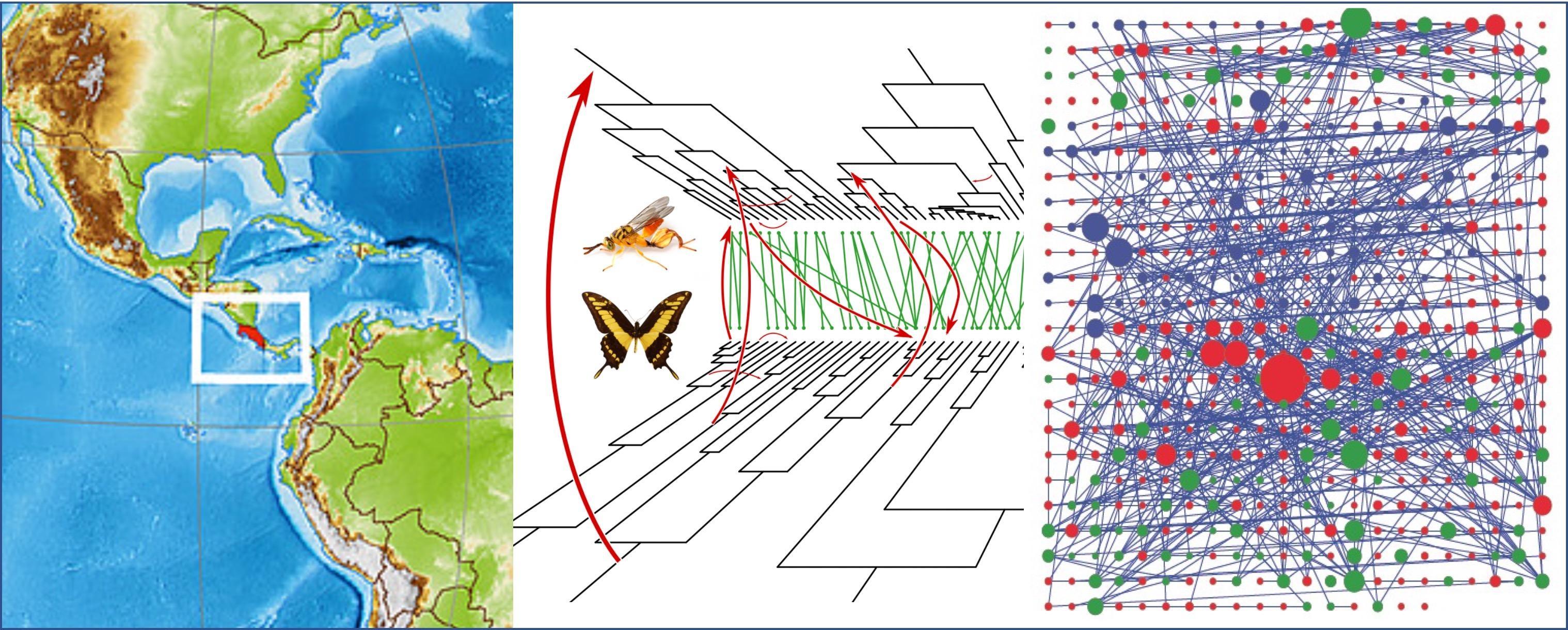
COEVOL Multi-Scale Coevolution
Evolutionary Genetics of Interactions Group
Charlat Sylvain
Chargé de recherche
CNRS
Who are I? Who am we?
These enigmatic questions, borrowed from my colleague and friend Fabrice Vavre, run through most of my work.
Who are I? Who am we?
These enigmatic questions, borrowed from my colleague and friend Fabrice Vavre, run through most of my work.
- Who are I? What multitude of genes, cells, symbiotic partners, compose biological "individuals"? And to what extent do these different degrees of organization also constitute individuals, i.e., effective targets of natural selection, carrying adaptations of their own, potentially deleterious at other scales?
- Who am we? To what extent should the collective, from the ant colony to the ecosystem, also be perceived as an incipient individual ?
As opportunities of collaborations arose, these questionings gave rise to various research projects that are briefly described below. Symbiotic relationships, approached in particular through evolutionary genomics in arthropods, occupy a prominent place, alongside modeling, didactics, and more recently, epistemology.
To discuss these topics, or to learn about possible opportunities to join us, please feel free to contact me.

AS IT COMES...
RESEARCH THEMES
We seek to test the hypothesis that parasitoids, particularly via domesticated viruses, would constitute preponderant vectors of horizontal transfers.

Of all symbiotic lineages of bacteria, Wolbachia is probably both the most abundant and the most diverse in terms of evolutionary implications. Its vertical maternal transmission has led it to evolve very particular invasion strategies, often beneficial to females (and more precisely, to the cytoplasmic lineage, transmitted by females) and on the contrary deleterious to males.
Wolbachia has always been central to our work, especially concerning its epidemiological dynamics and evolutionary consequences, at the scale of arthropod communities, and the genetic architecture of cytoplasmic incompatibility.

For more details:
- The paper of Beckmann et al, an analysis of different models of cytoplasmic incompatibility, and more recently, that of Namias et al
- The papers of Cariou et al (2017, 2020) on the consequences of Wolbachia on mitochondrial evolution
- The paper of Bailly-Bechet et al on Wolbachia acquisition / loss dynamics
As powerful as DNA variations may be in explaining evolution, what might be the contribution of other modes of inheritance to adaptive evolution ?

The teaching of evolutionary biology is reputed to be difficult. Beyond ideological reasons, this reveals how hard (but important) it is to deal with uncertainty in science teaching, and science in general.
For more details:
- Some papers (in French !) by Paulin et al (2018, 2019, 2020) sur ce sujet
- A short note (also in French !) published in the "café pédagogique"
If, in an evolutionary perspective, the individual is recursively conceived as resulting from the merging of individuals of lower scale, how did the smallest scale, the first, come to be?
What were the first units of selection, the first sparks of life? How to define and describe their properties, which necessarily implies combining biological and physico-chemical concepts? Where does individuality begin, and with it evolution by natural selection? In the uncertain hypothesis that such units of selection could exist outside the living world, in other physico-chemical systems, how to recognize them ?
Publications
Display of 31 to 60 publications on 80 in total
On the genetic architecture of cytoplasmic incompatibility: inference from phenotypic data
The American Naturalist . 182 ( 1 ) : 15-24
DOI: 10.1086/670612
Journal article
see the publicationIs RAD-seq suitable for phylogenetic inference? An in silico assessment and optimization
Ecology and Evolution . 3 ( 4 ) : 846-852
DOI: 10.1002/ece3.512
Journal article
see the publicationDraft genome sequence of the male-killing Wolbachia strain wBol1 reveals recent horizontal gene transfers from diverse sources
BMC Genomics .
Journal article
see the publicationMod/Resc Parsimony Inference: Theory and application
Information and Computation . 213 : 23-32
Journal article
see the publicationMaking (good) use of Wolbachia: what the models say.
Current Opinion in Microbiology . 15 ( 3 ) : 263-8
Journal article
see the publicationWolbachia detection: an assessment of standard PCR protocols.
Molecular Ecology Resources . 11 ( 3 ) : 567-72
Journal article
see the publicationWolbachia Age-Sex-Specific Density in Aedes albopictus: A Host Evolutionary Response to Cytoplasmic Incompatibility?
PLoS ONE . 5 ( 3 ) : e9700
Journal article
see the publicationRapid spread of male-killing Wolbachia in the butterfly Hypolimnas bolina
Journal of Evolutionary Biology . 23 ( 1 ) : 231-235
Journal article
see the publicationRéhabilitation de Athous puncticollis Kiesenwetter, 1858, espèce distincte de A. vittatus Fabricius, 1792
Bulletin de la Société Entomologique de France . 115 : 381 - 385
Journal article
see the publicationMod/Resc Parsimony Inference
Combinatorial Pattern Matching . 6129 : 202--213
Conference paper
see the publicationÉvolution des interactions entre espèces
Biologie évolutive . : 533-616
Book chapter
see the publicationRapidly Shifting Sex Ratio across a Species Range
Current Biology . 19 : 1628-1631
Journal article
see the publicationContribution à la connaissance des araignées des îles de la Société (Polynésie française)
Revue arachnologique, série 2 . 17(5) : 63-81
Journal article
see the publicationThe joint evolutionary histories of Wolbachia and mitochondria in Hypolimnas bolina
BMC Evolutionary Biology . 9(64) : 1-9
Journal article
see the publicationAssessing risks of Wolbachia DNA cross-specimen contamination following mass collection and ethanol storage
Molecular Ecology Resources . 9(1) : 46-50
Journal article
see the publicationYou can`t keep a good parasite down: evolution of a male-killer suppressor uncovers cytoplasmic incompatibility
Evolution international journal of organic evolution . 62 : 1258-1263
Journal article
see the publicationA Survey of the Bacteriophage WO in the Endosymbiotic Bacteria Wolbachia
Molecular Biology and Evolution . 24 : 427-435
Journal article
see the publicationMale-killing bacteria trigger a cycle of increasing male fatigue and female promiscuity
Current Biology . 17 : 273-277
Journal article
see the publicationMale rarity and putative sex-role reversal in Fijian damselflies (Odonata)
Journal of Tropical Ecology . 23 : 591-598
Journal article
see the publicationDisrupting the timing of Wolbachia-induced male-killing
Biology Letters . 3 : 154-156
Journal article
see the publicationExtraordinary flux in sex ratio
Science . 317 ( 5835 ) : 214-214
Journal article
see the publicationEvolution of Male Killer Suppression in a Natural Population
PLoS Biology . 4 : 1643-1648
Journal article
see the publicationThe evolution of cytoplasmic incompatibility types: integrating segregation inbreeding and outbreeding
Genetics . 172 : 2601-2611
Journal article
see the publicationOutbreeding selects for spiteful cytoplasmic elements
Proceedings of the Royal Society B: Biological Sciences . 273 : 923-929
Journal article
see the publicationCompeting selfish genetic elements in the butterfly Hypolimnas bolina
Current Biology . 16 : 2453-2458
Journal article
see the publicationPrevalence and penetrance variation of male-killing Wolbachia across Indo-Pacific populations of the butterfly Hypolimnas bolina
Molecular Ecology . 14 : 3525-3530
Journal article
see the publicationExploring the evolution of Wolbachia compatibility types: a simulation approach
Genetics . 170 : 495-507
Journal article
see the publicationInteractions between inherited bacteria and their hosts: The Wolbachia paradigm
incollection . -- : 119-141
Journal article
see the publication